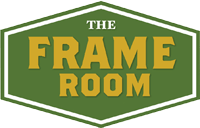A first, but often confusing step in custom framing is mounting, commonly called dry-mounting, your poster, print, or other artwork. Learn about dry-mounting materials and process here.
How to Choose Custom Framing Mounting
At The Frame Room, our core philosophy is to educate and inform our customers during the picture framing decision process and empower them to make the best decision for their personal needs. For many of our customers, they are picking out framing and/or matting for a highly personal, sentimental, and valuable object. To some, they are simply framing a poster, print, sports jersey, or diploma to protect it from the elements and ravages of time. This article will help to outline the differences of the kinds of mounting we carry and shed light on their recommended uses to ensure the best job for your framing dollar.
I’d like to begin by providing a little background on mounting or dry-mounting as it is commonly called? We utilize a vacuum press to dry-mount your poster, art print or other artwork to a rigid board ready for framing. This is one of the biggest differences between do-it-yourself (DIY) framing and professional framing. You've seen it, a picture in a frame that seems to be buckling, bubbling, or falling down in the frame. That won't happen to your frame piece with our technique. Furthermore, no matter how hard you you press and how evenly you think you apply pressure with spray mounting adhesives, it will bubble and it will look bad over time. Moisture and humidity are almost as relentless as gravity; the other thing dry-mounting your artwork or poster fights and wins!
We offer the following mounting substrates with their description and uses:
- Our standard dry-mounting. This pH neutral, but not acid free board, is great for everyday framing applications. It is available in 1/8" and 3/16" thickness.
- Artcare Restore© reversible mounting board. This is an acid free and reversible mounting board great for valuable posters, art work, and photography. If you think you may ever sell a valuable piece or wish to reverse the mounting process, this is your board.
- Acid free foam core with reversible, acid free, archival mounting tissue. Similar to Artcare Restore© but the board isn't coated with the adhesive, instead we use an acid free mounting tissue. A more old school solution to this problem, but still use full.
- Black foam core mounting board. This is important...use on newspapers or two-sided documents you do not want the reverse side showing through. White foam core will allow this to happen. This black foam core is acid free and will reduce the degradation of your artwork.
- Linen backing of posters with the acid free mounting tissue. This is a conservation technique to basically reinforce an old, brittle, or valuable document. It is widely accepted among collector of valuable vintage posters and movie posters. The more modern day acid free mounting tissue replaces the more traditional rice paper. This process was messy and frankly, i do not miss it.
- Hanging on acid free foam core using acid free linen tape. This technique is for posters, art prints, or artwork you just don't want to mount or for diplomas with embossed seals or again, you just don't want to mount.
- We also use hot glue and stitching methods for mounting of objects (i.e. masks) and fabric or cross stitching/needlework. Typically it is mounted on acid free board or acid free matboard.
We hope you have found this article informative. This article is part of a 6 part series intended to introduce you to all the components and levels of framing. The series includes:
- Picture Frame Matting. How do I Choose?
- Wood or Metal Frames. How to Choose a Frame.
- How to Choose the Correct Picture Frame Glazing.
- How to Choose Custom Frame Mounting.
- What Exactly Does Conservation Framing Mean?
- What the Heck is a Shadowbox Frame Anyway?
We look forward to being there to serve all of your custom picture framing needs.

You must be logged in to post a comment.
click here to log in